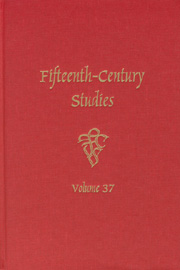Book contents
- Frontmatter
- Contents
- Essays
- Tradition and Innovation in 15th and 16th Century Popular Song Poetry: From Oswald von Wolkenstein to George Forster
- The Poet at the Mirror: René d'Anjou and Authorial Doubling in the Livre du Cœur d'Amour épris
- Modern Translator or Medieval Moralist?: William Caxton and Aesop
- A Battle of “Trechour Tung[s]”: Gaelic, Middle Scots, and the Question of Ethnicity in the Scottish Flyting
- Wheels and Wycliffites: The Role of Sacred Images in Capgrave's The Life of Saint Katherine
- Sympathy for the Devil: Gilles de Rais and His Modern Apologists
- Milieu, John Strecche, and the Gawain-Poet
- Thinking on Paper: Reference Tools, Tables, and Diagrams in Conrad Buitzruss's Compendium (Clm 671)
- Book Reviews
Tradition and Innovation in 15th and 16th Century Popular Song Poetry: From Oswald von Wolkenstein to George Forster
from Essays
Published online by Cambridge University Press: 05 February 2013
- Frontmatter
- Contents
- Essays
- Tradition and Innovation in 15th and 16th Century Popular Song Poetry: From Oswald von Wolkenstein to George Forster
- The Poet at the Mirror: René d'Anjou and Authorial Doubling in the Livre du Cœur d'Amour épris
- Modern Translator or Medieval Moralist?: William Caxton and Aesop
- A Battle of “Trechour Tung[s]”: Gaelic, Middle Scots, and the Question of Ethnicity in the Scottish Flyting
- Wheels and Wycliffites: The Role of Sacred Images in Capgrave's The Life of Saint Katherine
- Sympathy for the Devil: Gilles de Rais and His Modern Apologists
- Milieu, John Strecche, and the Gawain-Poet
- Thinking on Paper: Reference Tools, Tables, and Diagrams in Conrad Buitzruss's Compendium (Clm 671)
- Book Reviews
Summary
While scholarly devotion to texts and documents from the Middle Ages often engenders spirited debate, we must also dedicate analytic interpretation to the study of context itself, hence of the manuscript as a holistic entity. Parchment was expensive, and the typical medieval horror vacui — vividly reflected, for instance, in the nuns' choir of the famous Cistercian convent of Wienhausen near Celle, Germany — often led to the curious phenomenon of manuscripts filled from cover to cover with all kinds of texts, these lacking a specific ordering principle even if not factoring in the often highly embellished margins and illustrations. Thus we might as well assume that paleographers and others, when scrutinizing these texts, must overcome the apparently random system that seems to have held sway because scriptorial bookmakers had to conserve space. As scholarship has observed for some time, chronicle literature, as one example, has often survived in rather crammed quarters. Occasionally, it is difficult to ascertain where one text concludes and the other begins, such as in the rich and voluminous world chronicle by Jans Enikel from the time after 1272, when Enikel began to compose the historical account. As Graeme Dunphy now describes this annalist's compilation process: “Jans assembles material from a variety of sources, including oral traditions, which he reworks freely, preferring a good story to an authoritative report.” One of the numerous literary examples proves to be his narrative “Sir Friedrich von Auchenfurt,” which suddenly appears in the middle of the text, devoid of specific markers to signal any shift of genre, topic, theme, or focus.
- Type
- Chapter
- Information
- Fifteenth-Century Studies 37 , pp. 1 - 16Publisher: Boydell & BrewerPrint publication year: 2012



